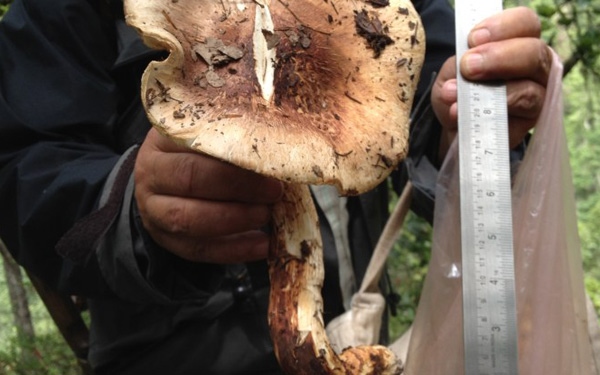Bhutan's Forest Resources Under Pressure: Villagers Adapt To Change
Sustainable forest management helps preserve spiritual life, livelihoods.
 Matsutake (Tricholoma matsutake) mushrooms grow in the forests of Bhutan.
(Source: CIFOR/Tshewang Dorji)
Matsutake (Tricholoma matsutake) mushrooms grow in the forests of Bhutan.
(Source: CIFOR/Tshewang Dorji)
By Kate Evans | Forests News
Tshewang Dorji is a forestry researcher. When he is in Bhutan, he usually works in the city – but on his days off, like many Bhutanese people, he makes time to go to the forest, to visit sacred sites, and offer prayers.
“I feel more relaxed, happy and content after every visit,” he says. “It simply boosts your peace of mind and spirituality. People from all walks of life in Bhutan go and visit these places.”
One such site is a meditation cave, Tselung Nye, said to be visited in the 9thCentury AD by Guru Rinpoche – a revered figure regarded by Bhutanese as a “second Buddha.” Another is an enormous, old-growth oak tree called Gomju Drake in the middle of the village of Sheling in central Bhutan. It is draped in orchids and ferns, and the clear water of a spring flows from its base. Villagers believe the majestic tree grew when a local guru planted his walking stick upside-down in the sacred soil, says Dorji.
“They believe that if they disturb that area it would bring a bad omen to the village – there would be sudden changes in the weather patterns, or a storm would come and destroy their crops, or they wouldn’t get rainfall on time.”
Green leaders
In the deeply Buddhist nation of Bhutan, high in the Himalayas, forests have huge cultural, spiritual, and practical importance – and that has helped to make it one of the world’s most forested nations. More than 70 percent of the country is covered in forest, and the constitution demands that a minimum of 60 percent of Bhutan’s total land shall remain under forest cover in perpetuity.
The country is famous for its “green” approach – and local values and religious beliefs coexist with conservation.
All government policies are measured against the country’s innovative “Gross National Happiness” development framework, which equally prioritizes environmental sustainability with cultural preservation, socioeconomic development and governance. Bhutan’s forest cover and low population have made it the only “carbon-negative” country in the world – and it holds the Guinness World Record for the most trees planted in one hour.
But on the ground, how do local people view their forests?
Researchers at the Ugyen Wangchuck Institute for Conservation and Environmental Research (UWICER), along with colleagues from the Center for International Forestry Research (CIFOR), have begun an assessment of the multiple ecosystem services provided by Bhutan’s forests, including local perceptions of their importance.
They started with a literature review, looking for evidence of connections between forests and the Gross National Happiness framework. They then set out to make an assessment in the field of three forest types under distinct management regimes: high-altitude evergreen oak forests, community plantations and government reserve forest management units.
The results of the first phase of research were reported in a recent article in the journal Forests.
Food, fuel, fungi and fodder
Dorji led the section of the research on high-altitude evergreen oak forests, found between 2,200 and 3,500 meters above sea level. These forests are especially important for Bhutan’s temperate farmers.
“People obtain most of their goods and services from these forests,” Dorji said. “The most important, as highlighted by them, is fresh water. The forests act as a water tower – they capture snowmelt and rainfall, and release the water gradually to downstream communities, so the rivers flow throughout the year.”
Local people use timber for their houses, gather firewood, and their cows and yaks graze in the nearby alpine meadows and under the trees. “Grazing is traditionally and culturally a very important part of the lifestyle of these communities,” Dorji said.
Conventional forest management recommends against grazing, because of the damage to young saplings – but restricting access in Bhutan would have a huge economic and social impact, he added. Authorities are therefore considering how grazing can be sensibly incorporated into management plans.
Also important is the collection of leaf litter from the forest floor. Traditional practices thousands of years old govern this activity, regulating who can gather leaf litter from where and at what times, said Robin Sears, a CIFOR researcher involved in the study.
“We can’t overemphasize the importance of the fodder and leaf-litter collection in these forests for communities,” she said.
Farmers bring the leaf litter home and use it as bedding material for their livestock. Once it’s soaked with urine and dung they compost it, then spread it on their fields – an incredibly rich, organic fertilizer that brings nutrients from the forest to the farm.
Bhutan aims to become 100 percent organic by 2020, Sears said. “The maintenance of the system of litter collection is critical if they want to achieve that.”
Mushrooms are another high-value forest product, Sears added. “A number of mushroom species are collected in all forest types – they are very important economically, there’s a great market for them, but also they’re very much appreciated by the Bhutanese for home consumption – they’re a real delicacy.”
Some families sun-dry them for use in the off-season, Dorji said – and that’s his favorite way of enjoying them. “Cooked with beef they’re really delicious.”
Every silver lining has a cloud
Bhutan’s forest cover has actually increased in recent years, partly as a result of urbanization, as people leave their farms.
“There’s a big push for modernization and a big out-migration of rural people to urban areas,” Sears said. “Youth are leaving for the cities, and wildlife – predators – are coming back.”
That is leading to conflict, Dorji said. “In the forests we studied, people perceived an increase in the abundance of wild animals like deer, bear, wild boar – and people are facing problems with human-wildlife conflicts.”
“More research into finding meaningful ways of addressing these conflicts would be helpful.”
Even if the overall area of forest is increasing, near the villages, timber and fuelwood is becoming harder to find. Villagers are concerned about the sustainability of their forest resources.
“In the past, about 20 years back, we could fetch our timber requirement for house construction and renovation from the nearby forests, about 10 to 15 minutes walking distance from the house,” one 45-year-old man told the researchers. “Now, we have to travel more than 5–6 hours by trucks looking for firewood and timber.”
Counting the benefits
Himlal Baral, a CIFOR scientist who oversees the project – part of the “Sloping Lands in Transition” (SLANT) initiative – says the research provides useful information for policymakers as well as lessons for other countries.
“Our study demonstrates that sensible conclusions can be drawn using a relatively simple conceptual approach and readily-available data and tools, which can be applicable to other mountainous and data-poor regions.”
But the current qualitative studies are just the first stage of what the researchers hope will be a longer, more quantitative study. Funding permitting, they want to measure the ecosystem services provided by these forests. How much fuel, fodder and food do they provide? What exactly are the downstream effects of forestry activity upstream? How do different forest management practices impact ecosystem services?
What the project has already shown, is that people see the forest as the infrastructure that provides them with their basic needs – fresh water, fresh air, fertilizers for their fields, cultural and spiritual services, Sears said.
Forest governance in Bhutan is shared by communities, private land owners and government. One aim of this project is to provide feedback to stakeholders on how current forest management activities are working – and what might help to preserve.
“People know their forests, they know the importance of them, and they need the goods and services they provide,” Sears said.
“It’s part of the Bhutanese identity to have this incredibly forested nation – Bhutan is very much identified with its forests.”
In many ways, forests are at the center of what it means to be Bhutanese.
This article was first published in Forest News and has been edited for the Daily Bhutan.




